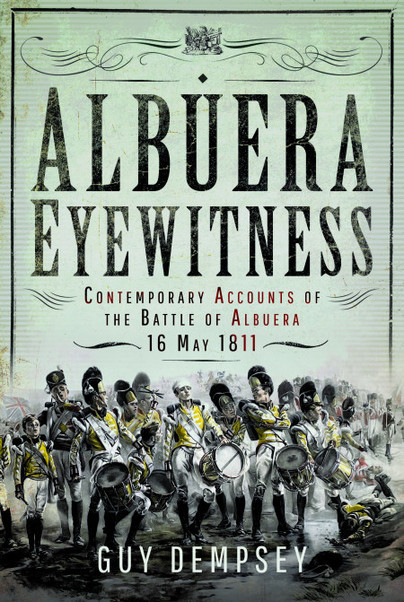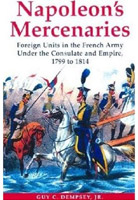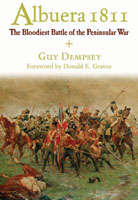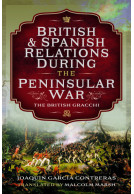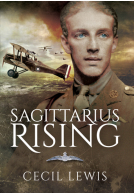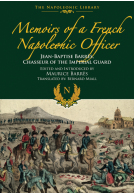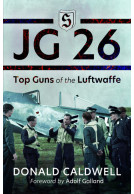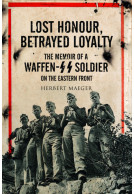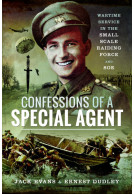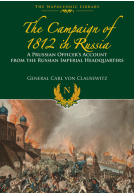Albuera Eyewitness (Hardback)
Contemporary Accounts of the Battle of Albuera, 16 May 1811
(click here for international delivery rates)
Need a currency converter? Check XE.com for live rates
| Other formats available - Buy the Hardback and get the eBook for £1.99! | Price |
|---|---|
| Albuera Eyewitness ePub (22.8 MB) Add to Basket | £6.99 |
On 16 May 1811, the small town of Albuera was the setting for one of the Peninsular War’s most bloody and desperate battles. A combined Spanish, British and Portuguese force of more than 30,000 men, under the command of Lord Beresford, stubbornly blocked the march of a smaller French force under Marshal Soult, who was trying to reach the fortress of Badajoz, twelve miles to the north. The Allies declared themselves the victors of the struggle but, given the extraordinary losses they suffered during the fighting, Wellington later declared that, ‘Another such battle will ruin us’. Several British regiments, including the 3rd, 48th and 57th regiments, suffered casualties of more than 50 per cent. The French similarly fought with enormous tenacity, and sustained even more casualties.
The purpose of this book is to tell the story of the battle exclusively by way of the recollections of those who fought in the battle on both sides, which make for both chilling and inspiring reading. The book contains more than 100 first-hand accounts include letters, diaries, official correspondence, army records, newspaper reports and memoirs. They range from the comprehensive after-action reports of the British, Portuguese, Spanish and French commanders to casualty and prisoner lists and to recollections of individual soldiers from all the combatant armies. Each account is accompanied by a commentary identifying the source and its context. Foreign language accounts have been translated into English but citations to the original text are always provided.
These first-hand accounts providing astonishing details of the intense fighting including the heroism of the Spanish troops, the massacre of Colborne’s brigade by Polish lancers, Beresford’s near-fatal indecisiveness, and the heroic charge of the Fusilier brigade.
“…this offers first-rate, contemporary info.”
Historical Miniatures Gaming Society
Read the full review here
This new book is in many respects a companion to Albuera 1811: The Bloodiest Battle of the Peninsular War by the same author, published by Frontline in 2008, in that it consists mainly of accounts and narratives written by participants, most of which were referenced in the earlier book but are quoted here at greater length. It also includes several accounts discovered more recently.
Arthur Harman, Miniature Wargames
In his Introduction, Guy Dempsey states that his purpose is to ‘present all the currently known significant eyewitness and first-hand accounts of the Battle of Albuera’ and that he hopes this book will encourage readers to examine the primary sources ‘to determine the relevant facts and produce their own version of the Albuera story.’ He distinguishes ‘eyewitness’ and ‘first-hand’ accounts by explaining that the former is ‘a written record of things seen directly by the writer’, whereas the latter ‘includes information obtained from other participants that was not observed or created directly by the writer.’ He advises readers that ‘most of the accounts in this volume are actually both of these at the same time’, giving the example of a writer describing the actions of his own regiment but including overall casualty figures which he could only have obtained from others. He poses a list of thirteen ‘big questions’ about the battle, such as ‘Did Soult know that he was seriously outnumbered when he launched his attack?’ and ‘What circumstances led to the destruction of Colborne’s brigade by the French cavalry?’
Part I offers a short description of the Strategic Context, a Chronology of Events, Early 1811 and a Chronology of Events, Thursday, 16 May with approximate timings.
Part II presents Anglo-Portuguese accounts, presented by arm of service so that first there are Command and Staff accounts by Marshal William Carr Beresford, his chief of staff Benjamin D’Urban, and Major-General William Stewart, commanding 2nd Division.
There follow accounts by members of the 1st Brigade: Lieutenant Colonel John Colborne, the brigade commander; Captains Arthur Gordon and William Stephens, Assistant Surgeon John Morrison and an unidentified Private of the 3rd Foot; Major William Brooke, and Lieutenants Edward Close and William Wood and an unidentified Officer of the 48th Foot; Captain James Girdlestone and Lieutenants Charles Bayley, John Clarke, Robert Dobbin and George Crompton of the 66th Foot.
From Abercromby’s (2nd) Brigade: Lieutenants Moyle Sherer and S. Dickens 34th Foot; Captain Hardress Saunderson 39th Foot and details of the court martial of Lieutenant Alexander Morrow of that regiment.
From Hoghton’s (3rd) Brigade: Captain James Wilson 1/48th Foot; Lieutenant Colonel William Inglis and Ensign Benjamin Hobhouse 57th Foot; Lieutenant Charles Leslie and Ensign Thomas Hamilton 29th Foot.
From the Fourth Division, accounts include: staff officer Major Charles Broke; Lieutenant Colonel Henry Hardinge; ADC Captain Alexander de Roverea Sicilian Regiment; Major Sir Edward Blakeney and Sergeant John Cooper 2/7th Foot; Captain John Hill and Lieutenants John Harrison and Grismond Philipps 23rd Foot; and Captain Friedrich von Wachholtz, Brunswick Oels Corps.
King’s German Legion accounts are by Major General Charles Alten, commanding the 1st and 2nd Light Battalions, and Friedrich Lindau, 2nd Light Battalion.
The Cavalry accounts include letters by Colonel Robert Long and Lieutenant Colonel Lord Edward Somerset; diary entries by Lieutenant Charles Madden 4th Dragoons; and an observation by Trooper Thomas Bennett 13th Light Dragoons.
The Artillery is represented by accounts from Major Alexander Dickson, commanding the Portuguese Artillery; Major Julius Hartmann, commanding the British and KGL Artillery; Captain Andrew Cleeves and Second Lieutenant William Unger, KGL Artillery; and Second Captain Edward Whinyates RHA.
There are accounts by Portuguese officers and British officers in Portuguese service. Miscellaneous Accounts includes the Legend for the Battlefield Panorama reproduced in the illustrations.
Part III Spanish Accounts contains Captain General Franciso Xavier Castanos’s Dispatch and includes accounts by Adjutant General Antonio Burriel, Mariscal de Campo Jose de Lardizabal, Lieutenant General Francisiso Ballasteros, Mariscal de Campo Jose de Zayas, Brigadier Carlos de Espana, Cavalry Brigadier Casimiro Loy, Louis, Count of Penne-Villemure, Colonel Jose Miranda and Lieutenant General Joaquin Blake.
Part IV, French Accounts, contains both Marshal Soult’s Report in Le Moniteur Universel on 13 June 1811, and an unpublished version in the French Army Archives, together with accounts by Captain Edouard Lapene, General Jean-Baptiste Girard, surgeon Jean-Baptiste D’Heralde, General Jean Pierre Maransin, Second Lieutenant Perrin de Solliers, Sergeant Francois Lavaux, Captain Jean Vivien, Cavalry General Latour-Maubourg, Captain Jakub Kierzkowski, Second Lieutenant Kajetan Wojciechowski, Trooper Louis-Antoine Gougeat, Second Lieutenat Theophile de Bremond d’Ars, and Artillery Captain Pernet.
The ten modern maps that accompany the text are repeated from Albuera 1811, but a selection of historical maps, showing different interpretations of the battlefield topography, is included in the illustrations section of the book. That section also includes maps drawn by two of the eyewitnesses, Second Lieutenant William Unger, KGL Artillery, and Colonel Robert B. Long, together with a Portuguese map, a plan of the battle drawn in 1851 by Captains Felipe Solis and Juan Burriel of the Spanish Army, a map by William Faden and a Spanish map of 1811.
An alphabetical list of eyewitnesses, a bibliography and an index conclude the book.
Will many wargamers actually read so many contemporary accounts to devise their own narratives of Albuera? Would they not prefer to buy a book written by a historian who has already done that research – as has Guy Dempsey – read his conclusions about the battle, then design their wargame scenarios? A wonderful compilation of evidence that would surely be most appreciated by a PhD student researching Albuera.
About Guy Dempsey
GUY DEMPSEY has had a life-long interest in Napoleonic military history, with an emphasis on working with primary sources. He is the author of a number of authoritative works including Albuera 1811: The Bloodiest Battle of the Peninsular War.







